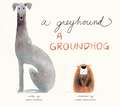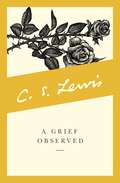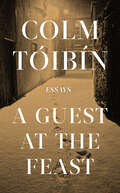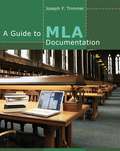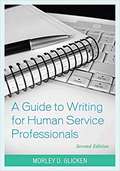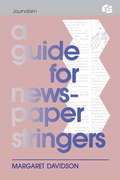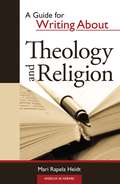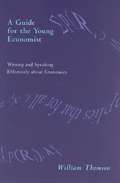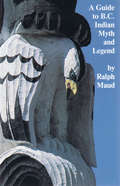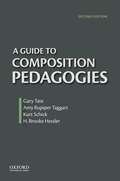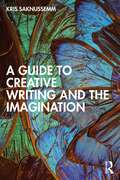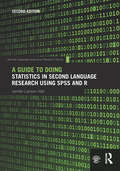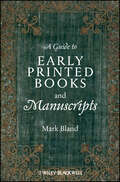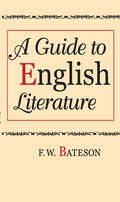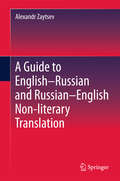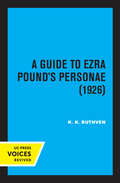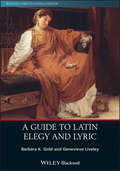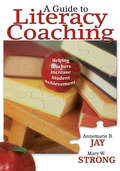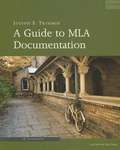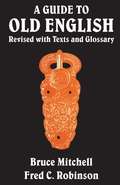- Table View
- List View
A Greyhound, a Groundhog
by Emily Jenkins"But what Emily Jenkins and Chris Appelhans&’ lyrical collaboration is really about is the intoxicating thrill of friendship, and boundless joy of play..." –The New York Times A &“merry read-aloud.&” –The Wall Street JournalWinner of the 2018 Zena Sutherland Award for Best TextFrom a heavyweight author and illustrator duo comes a delicious tongue twister of a picture book that features a little round greyhound and a little round groundhog. With very spare, incredibly lively language, this is an entertaining read-aloud, with two amazing—and oh-so-adorable—characters at its heart. When a greyhound meets a groundhog, wordplay and crazy antics ensue. The two animals, much like kids, work themselves into a frenzy as they whirl around and around one another. (Around, round hound. Around, groundhog!) The pace picks up (Around and around and astound and astound!), until they ultimately wear themselves out. &“Jenkins&’s masterful text is deceptively simple.&” —NPR on Toys Meet Snow by Emily Jenkins &“Appelhans, whose career up to now has been in animated films such as Coraline, is a revelation.&” —Booklist, Starred, on Sparky!, illustrated by Chris Appelhans &“Appelhans makes an auspicious picture book debut with strikingly beautiful watercolor and pencil illustrations. His style, reminiscent of Jon Klassen&’s, incorporates a muted color palette, but with a slightly softer, rounder quality, while also weaving in visual deadpan humor.&” —The Horn Book
A Grief Observed (Faber Paperbacks Ser.)
by C. S. LewisWritten after his wife's tragic death as a way of surviving the "mad midnight moment," A Grief Observed is C.S. Lewis's honest reflection on the fundamental issues of life, death, and faith in the midst of loss. This work contains his concise, genuine reflections on that period: "Nothing will shake a man -- or at any rate a man like me -- out of his merely verbal thinking and his merely notional beliefs. He has to be knocked silly before he comes to his senses. Only torture will bring out the truth. Only under torture does he discover it himself." This is a beautiful and unflinchingly homest record of how even a stalwart believer can lose all sense of meaning in the universe, and how he can gradually regain his bearings.
A Guest at the Feast: Essays
by Colm ToibinFrom bestselling and Booker-nominated author Colm Tóibín comes a beautiful collection of essays ranging from personal memoir to brilliantly acute writing on religion, literature and politics.From the melancholy and amusement within the work of the writer John McGahern to an extraordinary essay on his own cancer diagnosis, Tóibín delineates the bleakness and strangeness of life and also its richness and its complexity. As he reveals the shades of light and dark in a Venice without tourists and the streets of Buenos Aires riddled with disappearances, we find ourselves considering law and religion in Ireland as well as the intricacies of Marilynne Robinson's fiction.The imprint of the written word on the private self, as Tóibín himself remarks, is extraordinarily powerful. In this collection, that power is gloriously alive, illuminating history and literature, politics and power, family and the self.
A Guide To Historical Method
by Robert Jones ShaferThe beginning researcher, following the suggestions of this Guide, and of appropriate reference works, may certainly help to attain clarity of expression; in addition, with much practice, and possibly the help of God, he may aspire to achieve some day that style which Edmund Wilson defined as a combination of "lucidity, force, and grace."
A Guide To MLA Documentation (Ninth Edition)
by Joseph F. TrimmerBriefer, more affordable, and easier to use than the MLA's own handbook, this popular booklet features current MLA guidelines, a new section on evaluating online sources, and an up-to-date APA appendix. The guide also provides numerous examples, a sample research paper, and helpful hints on such topics as avoiding plagiarism and taking notes.
A Guide To Writing For Human Service Professionals
by Morley D. GlickenStraightforward and concise, the second edition of A Guide to Writing for Human Service Professionals offers students and professionals practical tools to improve their writing. In his animated and highly accessible teaching voice, Glicken presents the rules of punctuation, grammar, and APA style in jargon-free language that’s easy to understand. Chapters include detailed, real-world examples on how to write academic papers, client assessments and evaluations, business letters, research proposals and reports, papers for mass audiences, requests for funding, and much more. Glicken provides the most comprehensive writing guide available in an engaging and digestible format, including end-of-chapter exercises that allow readers to further practice their writing and critical thinking skills. A Guide to Writing for Human Service Professionals is an invaluable resource for current and future human service professionals across social work, psychology, and counseling.
A Guide for Newspaper Stringers (Routledge Communication Series)
by Margaret DavidsonFirst Published in 1990. Routledge is an imprint of Taylor & Francis, an informa company.
A Guide for Writing About Theology and Religion
by Mari Rapela HeidtEven the best students can improve upon their writing skills, and A Guide for Writing About Theology and Religion gives them the means to do so. This indispensable resource reviews the basics necessary for good scholarly religion writing, including how to correctly cite texts from various traditions; how to refer to people and rituals properly; and what common grammar, punctuation, and usage errors to avoid. Appendices provide listings of additional resources as well as a useful paper-writing checklist for students.
A Guide for the Young Economist: Writing and Speaking Effectively about Economics
by William ThomsonThis book is an invaluable guide for young economists working on their dissertations, preparing their first articles for submission to professional journals, getting ready for their first presentations at conferences and job seminars, or facing their first refereeing assignments. In clear, concise language--a model for what he advocates--William Thomson shows how to make written and oral presentations both inviting and efficient. Thomson covers the basics of clear exposition, including such nuts-and-bolts topics as titling papers, writing abstracts, presenting research results, and holding an audience's attention.
A Guide for the Young Economist: Writing and Speaking Effectively about Economics
by William ThomsonThis book is an invaluable guide for young economists working on their dissertations, preparing their first articles for submission to professional journals, getting ready for their first presentations at conferences and job seminars, or facing their first refereeing assignments. In clear, concise language--a model for what he advocates--William Thomson shows how to make written and oral presentations both inviting and efficient. Thomson covers the basics of clear exposition, including such nuts-and-bolts topics as titling papers, writing abstracts, presenting research results, and holding an audience's attention.
A Guide to B.C. Indian Myth and Legend
by Ralph MaudBoas, Teit, Hill-Tout, Barbeau, Swanton, Jenness, the luminaries of field research in British Columbia, are discussed here in A Guide to B.C. Indian Myth and Legend, and their work in Indian folklore evaluated. Other scholars, amateurs and Native informants of the past and present are given ample consideration, making this book a comprehensive survey of myth collecting in B.C. The aim is to reveal the true extent of this neglected body of world literature, and to begin to sort out the more valuable texts from those damaged in transmission. A Guide to B.C. Indian Myth and Legend is a valuable reference tool for beginning or advanced students of anthropology, and an absorbing look at the research process itself.
A Guide to B.C. Indian Myth and Legend
by Ralph MaudBoas, Teit, Hill-Tout, Barbeau, Swanton, Jenness, the luminaries of field research in British Columbia, are discussed herein, and their work in Indian folklore evaluated. Other scholars, amateurs, and Native informants of the past and present are given consideration, making this book a comprehensive survey of myth collecting in B.C. a valuable reference tool for beginning or advanced students of anthropology.
A Guide to Composition Pedagogies, Second Edition
by Gary Tate H. Brooke Hessler Amy Rupiper-Taggart Kurt SchickA Guide to Composition Pedagogies is the essential bibliographic guide written for newcomers to the field. Since our field has evolved quite a lot over the last decade, this long-awaited second edition contains many important changes, additions, and updates. At the same time, the practical organization and educational intent of the book have remained the same: The pedagogies themselves are categories commonly recognized in the disciplinary scholarship, and as with the first edition, each essay introduces the most important work in the field on the pedagogy, while attempting to offer readers a sense of the spirit of the approach, often through personal teaching narratives. t In short, this best-selling bibliographic guide familiarizes writing instructors with the current topography of Composition Studies and directs them to the best books and articles for further exploration. For this second edition, each author discusses some of the implications of technology for each pedagogy. In addition, the essays now focus more on practice and slightly less on theory.
A Guide to Creative Writing and the Imagination
by Kris SaknussemmTeaching creative writing for the multicultural, global, and digital generation, this volume offers a fresh approach for enhancing core writing skills in the major forms of Poetry, Fiction, Nonfiction, and Drama. A Guide to Creative Writing and the Imagination aims to provide students with organic, active learning through imitation and examples which not only emphasize writing and reading but look to other art forms for inspiration. This volume’s key features include: • Strengthening key underlying capabilities of what we mean by imagination: physical and mental alertness, clarity of perception, listening skills, attention to detail, sustained concentration, lateral thinking, and enhanced memory. • Taking direction from other art forms such as African American musical improvisation, Brancusi’s sculptural idea of “finding form,” key ideas from drawing such as foreground, background, and negative space—and some of the great lessons learned from National Geographic photography. • Incorporating techniques drawn from unusual sources such as advertising, military intelligence, ESL, working with the blind, stage magic, and oral traditions of remote indigenous cultures in Oceania and Africa. The work is intended for a global English market as a core or supplementary text at the undergraduate level and as a supporting frame at the M.F.A. level.
A Guide to Doing Statistics in Second Language Research Using SPSS
by Jenifer Larson-HallThis valuable book shows second language researchers how to use the statistical program SPSS to conduct statistical tests frequently done in SLA research. Using data sets from real SLA studies, A Guide to Doing Statistics in Second Language Research Using SPSS shows newcomers to both statistics and SPSS how to generate descriptive statistics, how to choose a statistical test, and how to conduct and interpret a variety of basic statistical tests. It covers the statistical tests that are most commonly used in second language research, including chi-square, t-tests, correlation, multiple regression, ANOVA and non-parametric analogs to these tests. The text is abundantly illustrated with graphs and tables depicting actual data sets, and exercises throughout the book help readers understand concepts (such as the difference between independent and dependent variables) and work out statistical analyses. Answers to all exercises are provided on the book’s companion website, along with sample data sets and other supplementary material.
A Guide to Doing Statistics in Second Language Research Using SPSS and R (Second Language Acquisition Research Series)
by Jenifer Larson-HallA Guide to Doing Statistics in Second Language Research Using SPSS and R, Second Edition is the only text available that demonstrates how to use SPSS and R as specifically related to applied linguistics and SLA research. This new edition is up-to-date with the most recent version of the SPSS software and now also includes coverage of R, a software program increasingly used by researchers in this field. Supported by a number of pedagogical features, including tip boxes and practice activities, and a wealth of screenshots, this book takes readers through each step of performing and understanding statistical research, covering the most commonly used tests in second language research, including t-tests, correlation, and ANOVA. A robust accompanying website covers additional tests of interest to students and researchers, taking them step-by-step through carrying out these tests themselves. In this comprehensive and hands-on volume, Jenifer Larson-Hall equips readers with a thorough understanding and the practical skills necessary to conducting and interpreting statisical research effectively using SPSS and R, ideal for graduate students and researchers in SLA, social sciences, and applied lingustics. For more information and materials, please visit www.routledge.com/cw/larson-hall.
A Guide to Early Printed Books and Manuscripts
by Mark BlandA Guide to Early Printed Books and Manuscripts provides an introduction to the language and concepts employed in bibliographical studies and textual scholarship as they pertain to early modern manuscripts and printed texts Winner, Honourable Mention for Literature, Language and Linguistics, American Publishers Prose Awards, 2010Based almost exclusively on new primary researchExplains the complex process of viewing documents as artefacts, showing readers how to describe documents properly and how to read their physical propertiesDemonstrates how to use the information gleaned as a tool for studying the transmission of literary documentsMakes clear why such matters are important and the purposes to which such information is putFeatures illustrations that are carefully chosen for their unfamiliarity in order to keep the discussion fresh
A Guide to English Literature
by F. W. BatesonAt first glance A Guide to English Literature may seem to be no more than a short bibliography of English literature with perhaps rather more extensive--and certainly more outspoken--comments on the principal editions, commentaries, biographies, and critical works than bibliographies usually provide. But it is something more: this guide contains long ""inter-chapters"" that provide reinterpretations of the principal periods of English literature in the light of modern research, as well as two final sections summarizing in unusual detail the literary criticism that exists in English and recent scholarship in the field. The purpose of this book, then, is to provide the reader with convenient access to a disciplined study of the texts themselves.This guide proposes itself as a new kind of literary history. The conventional history of literature has often tended to become a substitute for the reading of the literature it describes: the better the history, the greater the temptation to substitute it. The present combination of reading lists and inter-chapters cannot be a substitute for anything else. Meaningless as literature in themselves, they nevertheless provide the necessary preliminary information to meaningful reading. Since oddities of arrangement derive from these assumptions, the authors are not arranged alphabetically. Instead there are chronological compartments--with the divisions circa 1500, 1650, and 1800--in which authors succeed each other in the order of their births.This pioneering handbook is primarily a bibliographical laborsaving device. It is meant mostly for students and the general reader in that it stops where original research by the reader is expected to begin. However, the last chapter on literary scholarship is devoted specifically to the research specialist and provides indispensable equipment for the reader. There is also a general section on literary criticism which will be of use to all.
A Guide to English-Russian and Russian-English Non-literary Translation
by Alexandr ZaytsevLying at the intersection of translatology, cognitive science and linguistics, this brief provides a comprehensive framework for studying, investigating and teaching English-Russian/Russian-English non-literary translation. It provides a holistic perspective on the process of non-literary translation, illustrating each of its steps with carefully analyzed real-life examples. Readers will learn how to choose and process multidimensional attention units in original texts by activating different types of knowledge, as well as how to effectively devise target-language matches for them using various translation techniques. It is rounded out with handy and feasible recommendations on the structure and content of an undergraduate course in translation. The abundance of examples makes it suitable not only for use in the classroom, but also for independent study.
A Guide to Ezra Pound's Personae (1926)
by K. K. Ruthven"Both a commentary on and a critical appreciation of the work of the early Pound. It starts off with a luci introduction to Pound's technique in general, and to his imagist phase (during which the poems commented on in this book were written) in particular. In the critical passages Mr. Ruthven steers a sage middle course between the attitudes of uncritical adoration and wholesale rejection that mar so much of the literature on Pound. . . . informative without being pedantic, and exhaustive without being long-winded. . . .To turn to Mr. Ruthven's Guide is to follow in the footsteps of an intelligent, sensitive and reliable scholar." --English Studies This title is part of UC Press's Voices Revived program, which commemorates University of California Press's mission to seek out and cultivate the brightest minds and give them voice, reach, and impact. Drawing on a backlist dating to 1893, Voices Revived makes high-quality, peer-reviewed scholarship accessible once again using print-on-demand technology. This title was originally published in 1969.
A Guide to Latin Elegy and Lyric (Blackwell Guides to Classical Literature)
by Barbara K. Gold Genevieve LiveleyProvides the necessary context to read elegiac and lyric poetry, designed for novice and experienced Classics and Latin students alike A Guide to Latin Elegy and Lyric explores the language of Latin poetry while helping readers understand the socio-cultural context of the remarkable period of Roman literary history in which the poetry was composed. With an innovative approach to this important area of classical scholarship, the authors treat elegy alongside lyric as they cover topics such as the Hellenistic influences on Augustan poetry, the key figures that shaped the elegiac tradition of Rome, the motifs of militia amoris ("the warfare of love") and servitium amoris (“the slavery of love”) in Latin love elegy, and more. Organized into ten chapters, the book begins with an introduction to the literary, political, and social contexts of the Augustan Age. The next six chapters each focus on an individual lyric and elegiac poet—Catullus, Horace, Tibullus, Propertius, Ovid, and Sulpicia—followed by a survey of several lesser-known poets and post-Augustan elegy and lyric. The text concludes with a discussion of major tropes and themes in Latin elegy and lyric, and an overview and analysis of key critical approaches in current scholarship. This volume: Includes full translations alongside the Latin throughout the text to illustrate discussions Analyzes recurring themes and tropes found in Latin poetry such as sexuality and gender, politics and patronage, myth and religion, wealth and poverty, empire, madness, magic, and witchcraft Reviews modern critical approaches to elegiac and lyric poetry including autobiographical realism, psychoanalysis, narratology, reception, and decolonization Includes helpful introductory sections: "How to Read a Latin Elegiac or Lyric Poem" and "How to Teach a Latin Elegiac and Lyric Poem" Provides information about each poet, an in-depth discussion of some of their poetry, and cultural and historical background Features a dedicated chapter on Sulpicia, offering readers an ancient female viewpoint on sex and gender, politics, and patronage Part of the acclaimed Blackwell Guides to Classical Literature series, A Guide to Latin Elegy and Lyric is the perfect text for both introductory and advanced courses in Latin elegy and lyric, accessible for students reading the poetry in translation, as well as for those experienced in Latin with an interest in learning a different approach to the subject.
A Guide to Literacy Coaching: Helping Teachers Increase Student Achievement
by Annemarie B. Jay Mary W. StrongThis practical guide presents effective coaching strategies and best practices for enhancing literacy instruction, working with administrators and communities, and boosting student performance across all grade levels.
A Guide to MLA Documentation with an Appendix on APA Style
by Joseph F. TrimmerBriefer, cheaper, and easier to use than the MLA's own handbook, this popular booklet features current MLA guidelines, a new section on evaluating online sources, and an up-to-date APA appendix. The guide also provides numerous examples, a sample research paper, and helpful hints on such topics as avoiding plagiarism and taking notes.
A Guide to Old English: Revised With Texts And Glossary (Heritage Ser.)
by Bruce Mitchell Fred C. RobinsonA comprehensive introduction to Old English, combining simple, clear philology with the best literary works to provide a compelling and accessible beginners’ guide. Provides a comprehensive introduction to Old English Uses a practical approach suited to the needs of the beginning student Features selections from the greatest works of Old English literature, organized from simple to more challenging texts to keep pace with the reader Includes a discussion of Anglo-Saxon literature, history, and culture, and a bibliography directing readers to useful publications on the subject Updated throughout with new material including the first 25 lines from Beowulf with detailed annotation and an explanation of Grimm’s and Verner’s laws
A Guide to Old English: Revised with Texts and Glossary (The Royal Society of Canada Special Publications)
by Bruce Mitchell Fred RobinsonA Guide to Old English has established itself as the most thorough and most stimulating introduction to the language of Anglo-Saxon England. This revised edition adds ten basic texts, together with full notes and a comprehensive glossary, which convert the Guide into a self-contained course book for students beginning a study of Old English. The texts, such as Cynewulf and Cyneheard, the story of Caedmon and the conversion of Edwin, are those that have traditionally been chosen by teachers precisely becasue they offer the best introduction to the literature and culture of the time. They are arranged in order of increasing difficulty. The notes and glossary constantly refer to the grammatical explanations in the Guide, so that course is fully integrated and easy to follow.
